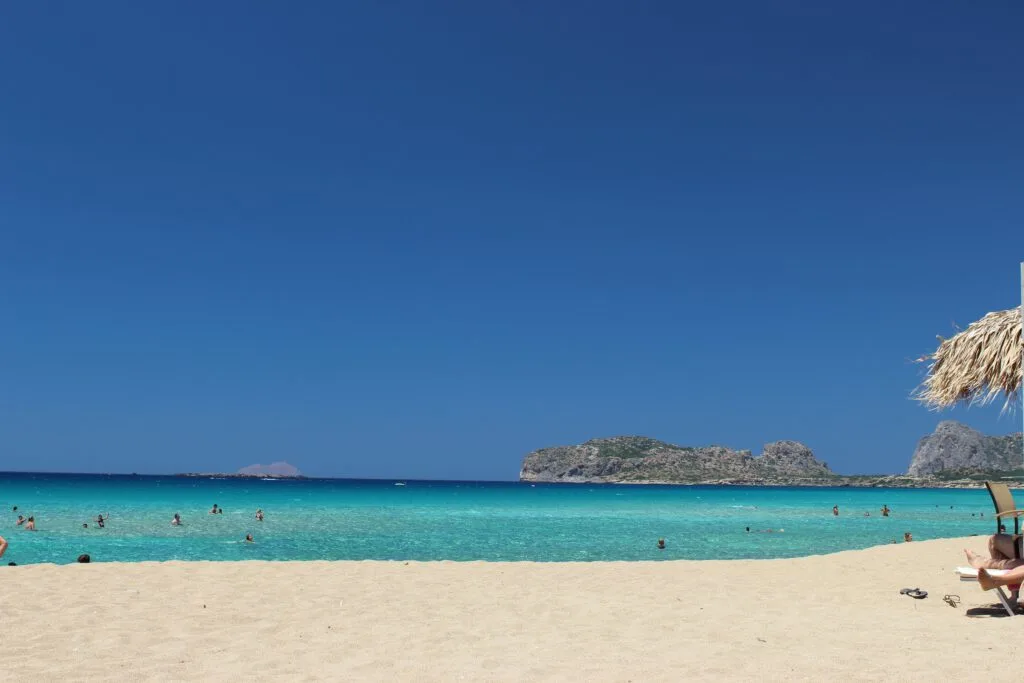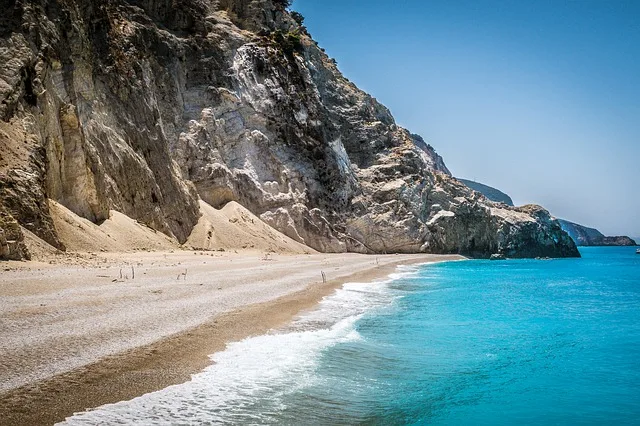Greece is many couples’ top choice for a honeymoon or romantic vacation. An awe-inspiring destination, Greece is filled with ancient historic sites, breathtaking scenery, friendly people, fun nightlife, delicious (and healthy!) food, and excellent inexpensive local wine.

If you’re considering a romantic trip or honeymoon to Greece, one of your first questions is probably, when is the best time to visit Greece? In this article, we’ll answer that question and tell you all you need to know about the best times to go to Greece, as well as when you should avoid Greece.
What is the cheapest time to go to Greece?
The cheapest time to go to Greece is in the winter. Prices are lowest from November through March, as very few people visit during this time. Many tourist sites are closed during winter, but there are still plenty of things to do (see Visiting Greece in the Winter, below).
The second cheapest time to go to Greece is during the shoulder season. The shoulder season in Greece is spring (April to May) and fall (September to October). You’ll also enjoy better weather and fewer crowds then, in addition to lower prices.
Summer is the high season for Greece. Prices are at their peak, so you will spend more if you visit in June, July, or August.

When should you avoid Greece?
As we said above, summer is the peak tourist season in Greece. The most popular time to visit Greece is summer. The months of July and August especially bring tons of tourists and the highest prices of the year.
August is when the locals take a vacation and travel around the country, so it is the most crowded month at popular sites and restaurants. Therefore, our pick for the worst month to visit Greece is August.
If you want to visit the Greek islands, you may want to avoid Greece during the winter months since tourist spots on most of the smaller islands shut down then, and bad weather can mess up inter-island ferries.
What is the rainy season in Greece?
The rainy season in Greece is winter, from November through March. There can be a good bit of rainfall in October as well. The rainiest months in Greece are November and December.
What is the best month to go to Greece?
The best month to travel to Greece is April, May, September, or October for a mix of good weather and reasonable prices.
Spring (April to June) and fall (September and October) are wonderful times to visit Greece, as the weather is pleasant, it’s not very crowded, and prices are lower than in the high season.

The best time of year to visit Greece for good weather is April through June or September through October. Temperatures are mild and rainfall is minimal, giving you plenty of beautiful days to get out and enjoy all Greece has to offer.
The average temperature in Athens in May goes from 61 to 75 degrees Fahrenheit. In June the average high is about 83 degrees F. Average temperatures in Athens in September range from 70 to 81 degrees F; October is 62 to 72. Temperatures on islands such as Crete will average a bit higher.
The best time to go to the beach in Greece
The best time to visit Greece for swimming and beach activities is June through September. The water is warmest during this time, and all beach bars and facilities are open.

July is the best month to visit Greece for a beach vacation. Temperatures are at their highest, sun is virtually guaranteed, and everything is open. However, the crowds will not be quite as intense as in August.
For a beach vacation on a budget, the best month to visit Greece is September.
The best time to visit Santorini and Mykonos
In the summer months of June, July, and August, Santorini and Mykonos are full of activities and exciting nightlife.
You will pay more to be part of the scene and there will be plenty of people there with you, but if you’re looking for the party atmosphere, summer is the best time to travel to the Greek islands.
The best time to visit Santorini and Mykonos is May or October if you want to enjoy them without the big crowds and top prices.

The best time to honeymoon in Greece
Travel experts recommend June and September as the best months to visit Greece for honeymoons. While June can be a bit more expensive, especially on the islands, you’re guaranteed that everything will be open, skies will be blue, and the weather perfect for swimming and exploring.
Prices in September will be lower, especially if you want to honeymoon on Santorini or Mykonos, so this can be a great month to honeymoon in Greece as well.

The best months for sightseeing in Greece
The best months for sightseeing in Greece are May, June, September, and October. Milder temperatures in these spring and fall months mean the weather is more comfortable for walking around outside for hours, exploring.

Visiting Greece in the Spring
Spring is a great time to visit Greece. In the spring, average temperatures range from 60 to 77 degrees Fahrenheit. Most tourist spots are open, but on some islands they may not be yet, so you’ll want to doublecheck everything if traveling there during this time.
If you visit Greece in the spring, consider being there during the Orthodox Easter celebrations, which last for four days. However, be aware that many Greeks travel during this time, so prices could be a bit higher and transportation crowded.

Another good time to be in Greece in the spring is on May 18th, International Museums Day, when all museums offer free admission.
During April and early May, wildflowers are in bloom, making this a great time to go hiking in Greece. The milder temperatures also make spring one of the best times to visit Athens, as you can climb around the ancient sites without getting too hot.
Days start to be longer in the spring, with sunlight for 13 hours in April and 14 hours in May.
Visiting Greece in the Fall
In the fall in Greece, the water is still warm enough for swimming, especially in September. Temperatures in the northern part of Greece range from 46-86 degrees F and in the center and south from 59-85 degrees F, with the weather getting cooler in October. Crete stays warm well into October, if you’re particularly interested in spending time on the beach.

October sees more rainfall, so pack some rain gear if you plan to visit Greece at this time. There are plenty of festivals during this season, but hardly any tourists, so you’ll have a much more relaxed Greek vacation in the fall. You can also visit local vineyards to see the grape harvest, and this is another of the best times to go hiking in Greece or visit Athens.
You’ll still have plenty of daylight in the fall, with 12.5 hours in September and 11.5 hours in October.

Visiting Greece in the Summer
Even though we have chosen August as the worst month to visit Greece, there are good reasons to visit Greece in the summer. The days are longest (around 15 hours of sunlight), everything is open, and Greece is at its liveliest. If you like a lot of action, or if you want to check out the summer festivals, summer is the best time to visit Greece for you.
Here’s what you need to know if you visit Greece in the summer. Summer in Greece is pretty hot and humid; high temperatures average 89 degrees F in the north and 90+degrees F in the center and south. In Athens, summer temperatures can top 100 degrees F.
There can also be high winds on the Greek islands during July and August, which can make going to the beach or walking around unpleasant. The good news is, there’s hardly any rain during this time. If you visit Greece in the summer, be sure to pack light clothing, sunscreen, and a hat to protect you from the sun.
Crowds are biggest in the months of July and August, so be prepared for lots of people on public transportation, long waits at top sites, and packed tables at restaurants. This is also when prices are highest.

Visiting Greece in the Winter
The low season and the least crowded time to visit Greece is winter. From November to March, temperatures drop and crowds disappear. Tourist spots on many of the smaller Greek islands shut down during the offseason, so there isn’t much to do if you visit there during this time. Bad weather can also affect ferry travel between islands.
But on the mainland and the biggest islands, winter can be a great time to visit Greece. for a lowkey experience, if you don’t mind it being colder and rainier. This is definitely the cheapest time to visit Greece, as it is low season for tourism. And while you won’t be able to swim and some attractions and restaurants may be closed, there are still plenty of things to do in Greece in the winter.
You can even see snow in Greece, in northern areas like Thessaloniki! You can actually go snowskiing in northern Greece from around December through May. It’s also fun to be in Greece during Christmas and New Year’s celebrations. Another good time to visit Greece is for the local Carnival season, Apokries, which usually happens in February (but is tied to the date of Orthodox Easter, so it moves from year to year). This festival lasts for 3 weeks and features vibrant street parties.
How cold does it get? That depends on what part of Greece you visit. Temperatures in the winter average around 50 degrees F. In the northern part of Greece, temperatures range from 15 to 59 degrees F, and in the center and south from 44-68 degrees F. Coastal cities tend to stay pretty mild.
Since winter is the rainy season in Greece, you will see a lot more rainfall if you come during this time so you should definitely pack rain gear in addition to warm clothing.

Did this article help you figure out the best time to visit Greece for your trip? If you’re ready to start planning, check out our articles on how much it costs to visit Greece, planning honeymoons in Greece, honeymoon packages in Greece, Santorini honeymoons, or Mykonos honeymoons!
Ashley has always loved to explore new places and indulges her passion for travel whenever she can. She has been to 12 countries and 32 states so far.
Ashley has worked as a freelance writer for more than 20 years, specializing in the areas of travel, marketing, personal development, and the pursuit of happiness.
Favorite destinations include Sorrento and Capri, Italy; Haarlem, Netherlands; Paris; Sydney and K’gari, Australia; Rotorua and Waiheke Island, New Zealand; the American West; Palm Beach; the Florida Keys; and her hometown of New Orleans. Ashley has a goal of visiting every state plus many more international destinations.

